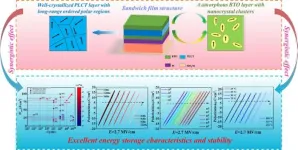(Press-News.org) MRI of the prostate, combined with a blood test, can help determine if a prostate lesion is clinically significant cancer, new research suggests
A new meta-analysis by investigators from Brigham and Women’s Hospital, a founding member of the Mass General Brigham healthcare system, suggests that doctors and patients can avoid unnecessary prostate biopsies by combining MRI of the prostate findings with prostate-specific antigen (PSA) density. This new approach to diagnosing clinically significant prostate cancer can decrease patient harm and health care costs of prostate biopsies. Their results are published March 29 in JAMA Network Open.
An enlarged prostate or potential prostate cancer is a common issue for older men. There will be approximately 300,000 new cases of prostate cancer in the U.S. this year. But not all those cancers require treatment — or even need to be biopsied.
"In the workup of men suspected of having prostate cancer, prostate MRI findings combined with PSA density measurement can help doctors decide which patients to biopsy," said senior author Ramin Khorasani, MD, MPH, Radiology Vice Chair for Quality and Safety at Brigham and Women’s Hospital and Mass General Brigham and Philip H. Cook Professor of Radiology at Harvard Medical School. "With this new analysis, we looked to see how MRI can help urologists decide which patients to biopsy and which patients may not need aggressive diagnosis and treatment."
Researchers have known for a long time that not all prostate cancer is dangerous. However, telling which cancers need treatment without a biopsy can be difficult. Biopsies, especially those of the prostate, can be uncomfortable, invasive, and expensive.
To doctors, clinically significant prostate cancer (csPCa) is prostate cancer that has a high chance of threatening a patient's life. They have cells that look more aggressive, or cancer is found outside of the prostate gland.
“Prostate cancer is the second most common cancer in men worldwide, but we need to be able to identify patients who require prostate biopsy while avoiding unnecessary procedures and minimizing the risk of missing clinically significant prostate cancer,” Adam Kibel, MD, chair of the Department of Urology and co-author of the study. “These findings suggest that patient-tailored prostate biopsy decisions based on information from MRI and blood tests could prevent unnecessary procedures while maintaining high sensitivity.”
MRI of the prostate can provide some of this information. Still, a biopsy is traditionally needed to determine how aggressive the cancer cells look. This study tested a new approach: combining MRI-based prostate imaging reporting and data system (PI-RADS) scores with prostate-specific antigen (PSA) density to determine which cancers were likely to be clinically significant without including information from a biopsy. PI-RADS scores the prostate lesion from 1 (highly unlikely to be clinically significant) to 5 (cancer is highly likely to be clinically significant). PSA density (PSAD) is the PSA blood level divided by the prostate's volume (as determined by MRI).
The JAMA Network Open study builds upon previous findings from a similar study using data only obtained at Brigham Women's Hospital, published in the Journal of the American College of Radiology in 2022. That study found that an analysis using PI-RADS and PSAD cutoffs could pinpoint up to 50% of cases in which a biopsy would be unnecessary. The new study, whose first and second authors are Arya Haj-Mirzaian, MD, MPH, and Kristine S. Burk, MD, did the same analysis on data from 72 previously published studies of men with prostate cancer, including their PI-RADS results, prostate-specific antigen density testing, and determination of clinical significance from a biopsy.
The meta-analysis gave them a dataset of more than 36,000 patients to determine if their earlier findings at BWH held in a more diverse sample set. They found that prostate biopsies may be unnecessary for patients with a PI-RADS under 4 and a PSAD below 0.10 ng/ml2. The researchers found that using specific PI-RADS and PSAD cutoffs, doctors could confidently skip 50% of biopsies while only missing 5% of clinically significant cancers, or they could skip 30% and only miss 3%.
"These data give us the confidence to say that in some cases, we can safely follow men with testing rather than aggressively pursue a biopsy in all cases," Kibel said. "By making this information available to physicians and patients, we can help them make a more informed decision about undergoing a biopsy."
The next step in this research is using the analysis to create an easy-to-use patient-level scoring system that urologists can use to evaluate their patient's need for a biopsy.
Authorship: In addition to Khorasani and Kibel, BWH authors include Arya Haj-Mirzaian, Kristine S. Burk, Ronilda Lacson, Daniel I. Glazer, and Sanjay Saini.
Disclosures: Lacson received funding from the Agency for Healthcare Research and Quality; Glazer received nonfinancial support from Siemens Healthineers for other work; and Kibel is a member of an advisory board for Blue Earth.
Funding: This work was funded by the Center for Evidence Based Imaging.
Paper cited: Haj-Mirzaian, A et al. "Magnetic Resonance Imaging, Clinical, and Biopsy Findings in Suspected Prostate Cancer: A Systematic Review and Meta-Analysis" Journal DOI: 10.1001/jamanetworkopen.2024.4258
END
New Brigham research highlights combining prostate MRI with a blood test to avoid unnecessary prostate biopsies
MRI of the prostate, combined with a blood test, can help determine if a prostate lesion is clinically significant cancer, new research suggests
2024-03-29
ELSE PRESS RELEASES FROM THIS DATE:
Scientists discover a key quality-control mechanism in DNA replication
2024-03-29
PHILADELPHIA – When cells in the human body divide, they must first make accurate copies of their DNA. The DNA replication exercise is one of the most important processes in all living organisms and is fraught with risks of mutation, which can lead to cell death or cancer. Now, in a landmark finding, biologists from the Perelman School of Medicine at the University of Pennsylvania and from the University of Leeds have identified a multi-protein “machine” in cells that helps govern the pausing or stopping of DNA replication to ensure its smooth progress.
The discovery, published today in Cell, advances the understanding of DNA replication, helps explain ...
Lipids with potential health benefits in herbal teas
2024-03-29
The lipids in some herbal teas have been identified in detail for the first time, preparing the ground for investigating their contribution to the health benefits of the teas.
Herbal teas are enjoyed worldwide, not only for their taste and refreshment but also for a wide range of reputed health benefits. But the potential significance of a category of compounds called lipids in the teas has been relatively unexplored. Researchers at Hokkaido University, led by Associate Professor Siddabasave Gowda and Professor Shu-Ping Hui of the Faculty of Health Sciences, have now identified 341 different molecular species from five categories of lipids in samples of four types of herbal ...
Synergically improved energy storage performance and stability in sol–gel processed BaTiO3/(Pb,La,Ca)TiO3/BaTiO3 tri-layer films with a crystalline engineered sandwich structure
2024-03-29
As a green, sustainable, and competitive technology relative to batteries and electrochemical capacitors and featuring a high charge storage capability, the dielectric capacitors excel in low cost, long cycle-life, and a broad operating temperature range, as well as environmental friendliness, high security, and good reliability. Most importantly, they top other technologies in terms of ultra-high-power density due to their unrivaled charge-discharge speed. These features have created a number of applications for them in power electronic devices and pulsed power equipment. Among the dielectric capacitors, the ferroelectric ones can provide a high energy density due to ...
International collaboration enabled participatory stock assessment on glass eel fisheries in West Java, Indonesia
2024-03-29
Joint Press Release with IPB University, WWF Indonesia, and WWF Japan
<Summary Text>
Appropriate fishery management requires an understanding of the target species' stock dynamics. However, in the Northern Hemisphere, illegal trade and IUU (Illegal, Unreported, and Unregulated) fisheries make the assessment of recruiting glass eels extremely difficult. Contrary, we have successfully collected sufficient data on glass eel fisheries for detailed statistical analysis based on a community-based participatory assessment. This study was conducted by NGOs, experts, and a broad range of stakeholders ...
Enhanced melanoma vaccine offers improved survival for men
2024-03-29
A second-generation melanoma vaccine being developed at UVA Cancer Center improves long-term survival for melanoma patients compared with the first-generation vaccine, new research shows. Interestingly, the benefit of the second-generation vaccine was greater for male patients than female patients. That finding could have important implications for other cancer vaccines, the researchers say.
The vaccine developers, led by Craig L. Slingluff Jr., MD, found that they could enhance the effectiveness of their melanoma vaccine by simultaneously stimulating important immune cells known as “helper ...
Nearly one-third of patients with TBI have marginal or inadequate health literacy
2024-03-29
Waltham — March 26, 2024 — Low health literacy is a problem for a substantial proportion of people with moderate to severe traumatic brain injury (TBI), according to research published in The Journal of Head Trauma Rehabilitation (JHTR). The official journal of the Brain Injury Association of America, JHTR is published in the Lippincott portfolio by Wolters Kluwer.
Angelle M. Sander, PhD, FACRM, Professor in the H. Ben Taub Department of Physical Medicine and Rehabilitation at Baylor College of Medicine and Director of TIRR Memorial Hermann’s Brain Injury Research Center, ...
Genetic causes of cerebral palsy uncovered through whole-genome sequencing
2024-03-29
A Canadian-led study has identified genes which may be partially responsible for the development of cerebral palsy.
Cerebral palsy (CP), a condition that affects the development of motor skills in children, is the most common childhood-onset physical disability. CP can have different causes, such as infections, injuries, or lack of oxygen before or during birth, but the genetic contributors to CP have remained largely unknown.
Novel research from scientists at The Hospital for Sick Children (SickKids), the Research Institute of the McGill University ...
Modesty and boastfulness – perception depends on usual performance
2024-03-29
When people present themselves as capable or humble, the way this influences other people’s evaluations of one’s true ability and character depends on one’s usual performance. Kobe University and University of Sussex researchers thus add an important factor in our understanding of how the relationship between self-presentation and perception develops with age.
People want to be liked. Amongst the many ways of achieving this, making statements about oneself to manipulate other people’s evaluation is called “self-presentation.” Both the ability to do so and the effect this has on others’ evaluation of one’s ability ...
Do sweeteners increase your appetite? New evidence from randomised controlled trial says no
2024-03-29
University of Leeds news
Embargo: Thursday 28 March 2024, 23:30 UK time
Do sweeteners increase your appetite? New evidence from randomised controlled trial says no
Replacing sugar with artificial and natural sweeteners in foods does not make people hungrier – and also helps to reduce blood sugar levels, a significant new study has found.
The double blind randomised controlled trial found that consuming food containing sweeteners produced a similar reduction in appetite sensations and appetite-related hormone responses ...
Women with obesity do not need to gain weight during pregnancy, new study suggests
2024-03-29
The guidelines for weight gain during pregnancy in obese women have long been questioned. New research from Karolinska Institutet supports the idea of lowering or removing the current recommendation of a weight gain of at least 5 kg. The results are published in The Lancet.
International guidelines from the US Institute of Medicine (IOM) state that women with obesity should gain a total of 5 to 9 kg during pregnancy, compared to 11.5 to 16 kg for normal-weight women. The guidelines have long been questioned, but there has been no evidence to warrant a re-examination.
A new study from Karolinska Institutet in Sweden now shows that there are no increased health risks for either the mother or ...
LAST 30 PRESS RELEASES:
Numbers in our sights affect how we perceive space
SIMJ announces global collaborative book project in commemoration of its 75th anniversary
Air pollution exposure and birth weight
Obstructive sleep apnea risk and mental health conditions among older adults
How talking slows eye movements behind the wheel
The Ceramic Society of Japan’s Oxoate Ceramics Research Association launches new international book project
Heart-brain connection: international study reveals the role of the vagus nerve in keeping the heart young
Researchers identify Rb1 as a predictive biomarker for a new therapeutic strategy in some breast cancers
Survey reveals ethical gaps slowing AI adoption in pediatric surgery
Stimulant ADHD medications work differently than thought
AI overestimates how smart people are, according to HSE economists
HSE researchers create genome-wide map of quadruplexes
Scientists boost cell "powerhouses" to burn more calories
Automatic label checking: The missing step in making reliable medical AI
Low daily alcohol intake linked to 50% heightened mouth cancer risk in India
American Meteorological Society announces Rick Spinrad as 2026 President-Elect
Biomass-based carbon capture spotlighted in newly released global climate webinar recording
Illuminating invisible nano pollutants: advanced bioimaging tracks the full journey of emerging nanoscale contaminants in living systems
How does age affect recovery from spinal cord injury?
Novel AI tool offers prognosis for patients with head and neck cancer
Fathers’ microplastic exposure tied to their children’s metabolic problems
Research validates laboratory model for studying high-grade serous ovarian cancer
SIR 2026 delivers transformative breakthroughs in minimally invasive medicine to improve patient care
Stem Cell Reports most downloaded papers of 2025 highlight the breadth and impact of stem cell research
Oxford-led study estimates NHS spends around 3% of its primary and secondary care budget on the health impacts of heat and cold in England
A researcher’s long quest leads to a smart composite breakthrough
Urban wild bees act as “microbial sensors” of city health.
New study finds where you live affects recovery after a hip fracture
Forecasting the impact of fully automated vehicle adoption on US road traffic injuries
Alcohol-related hospitalizations from 2016 to 2022
[Press-News.org] New Brigham research highlights combining prostate MRI with a blood test to avoid unnecessary prostate biopsiesMRI of the prostate, combined with a blood test, can help determine if a prostate lesion is clinically significant cancer, new research suggests




